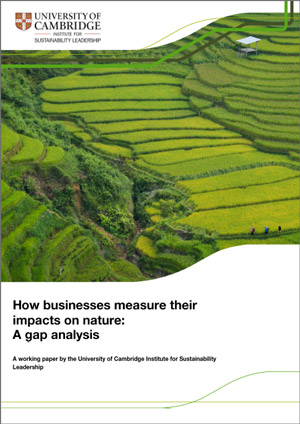May 2017 – Opportunities exist for investors and companies to demonstrate positive impacts and show they are reversing the trend of natural capital degradation. This working paper explores the challenges with identifying metrics that are relevant for businesses’ decision-making processes, whilst being simple and practical for investors to use.
It is concluded that there is a lack of comprehensive, commonly accepted metrics that can be used by business and investors to consistently demonstrate their impact upon natural capital.
CISL are working with a group of investors and multinational companies to explore and develop these metrics in response to this gap. This working paper represents the first output from CISL led research.
Publication date
May 2017
Key Findings
- There is a need for useful, simple and commonly accepted impact metrics that can help shape operational decision-making, engage with civil society, and respond to investor requests.
- Most businesses report on separate metrics rather than one aggregated value; this may not be as useful to the investor community.
- While water and carbon are relatively well monitored, biodiversity and soil are often not adequately assessed in impact metrics
- The environmental metrics that are currently available to businesses lack context.
- An extensive range of organisations support businesses in evaluating their impact and dependencies on the natural environment for the purposes of disclosure and decision-making; however, they do not provide consistency in recommended metrics.
- It is recommended that impact metrics should follow a set of principles to be meaningful; measurable and comparable; possible to aggregate; practical; easily accessible; replicable and credible; take into account local context; be responsive to changes in business practices; and drive business decisions.
Abstract
Investors and companies alike want to create long-term value by mitigating risks and improving their impact on the natural environment. Company productivity is dependent upon a resilient environment and reducing impacts is beneficial to both nature and business. Opportunities exist for investors and companies to demonstrate positive impacts and show they are reversing the trend of natural environment degradation. The challenge is to identify metrics that are relevant for businesses’ decision-making processes, whilst being simple and practical for investors to use.
A plethora of methodologies, standards and tools exist that help investors and businesses understand their interaction with the natural environment. However, these tend not to provide directional, specific information for companies to measure and demonstrate impacts upon the natural environment; instead they offer guidance.
Until consistent, context-based metrics are developed, natural capital measures will continue to be misunderstood and disregarded, and will not become mainstream in decision-making. This report assesses the drivers for companies to use impact metrics; evaluates the support that already exists; and identifies where the gaps are.
Authors
Dr Martina Di Fonzo, Postdoctoral Researcher, CISL and Dr Stephanie Hime, Little Blue Research, Ltd
Citation
Di Fonzo, M. & Hime, S., (2017), ‘How businesses measure their impacts on nature: A gap analysis’, University of Cambridge Institute for Sustainability Leadership (CISL), Working Paper 01/2017

 Download the working paper
Download the working paper

